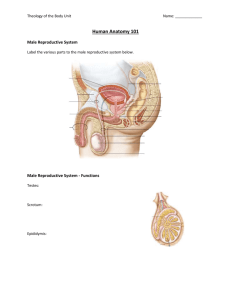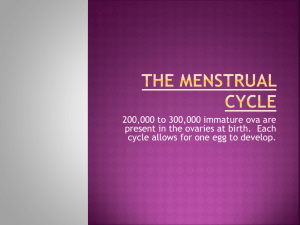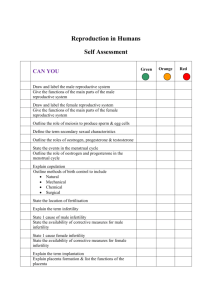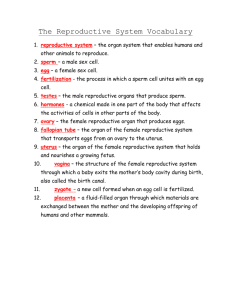Human Reproduction
advertisement
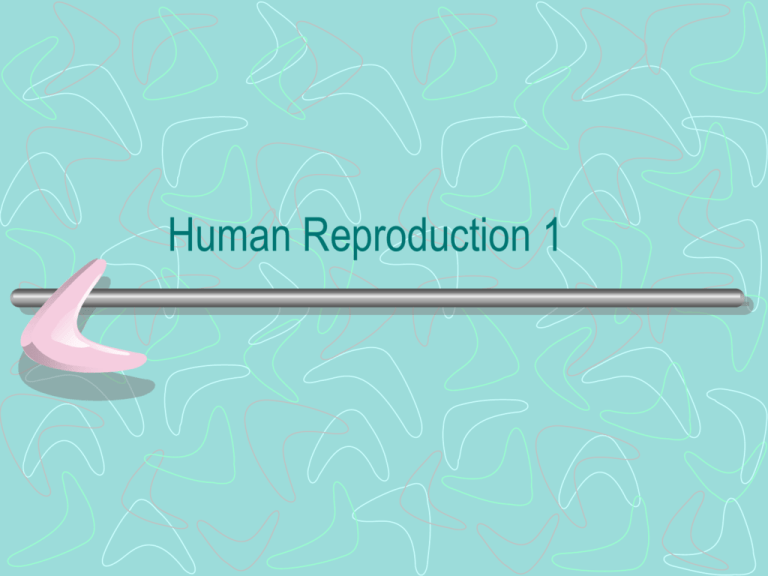
Human Reproduction 1 Contents Introduction The Male Reproductive System The Female Reproductive System The Menstrual Cycle 2 3 Introduction The human reproductive system is organised as follows: • paired structures for gamete production i.e. in the male – sperm and in the female – eggs (ova) • a series of tubes for transporting various substances • glands for secretion of hormones that control the entire process 4 The Male Reproductive System Contents Diagram – front view Diagram – front view Uncircumcised & circumcised penis Parts and Functions The male reproductive organs – side view – diagram Sperm formation in testes – slide Sperm – diagram Sperm – slide Male reproductive hormones 5 The male reproductive system 6 The male reproductive system 7 Uncircumcised and circumcised penis 8 Parts and Functions PART (1/2) FUNCTION Testis Produce sperm and hormone testosterone Scrotum Keeps testes at lower temperature for successful production of sperm (35°C) Seminiferous tubules Coiled tubes in testes – sperm made here by meiosis – chromosome no. halved from 2n to n Epididymis Coiled tube – sperm stored and mature here 9 Parts and Functions Vas deferens (2/2) Transports sperm from epididymis to urethra Seminal vesicles Prostate gland Make seminal fluid and provides nourishment and medium for sperm to swim Cowper’s gland Penis Organ of sperm release – top of penis protected by foreskin 10 The male reproductive organs 11 Testes, mammalian, tubule showing sperm formation 12 Sperm 13 Human sperm 14 Male reproductive hormones (1/2) Follicle stimulating hormone (FSH): produced by pituitary – stimulates certain cell of the testes to produce sperm Luteinising hormone (LH): produced by pituitary – stimulates other cells in the testes to produce testosterone 15 Male reproductive hormones (2/2) Testosterone: 1. stimulates the development of, and maintains, the secondary sexual characteristics e.g. broadening of the shoulders, growth and enlargement of penis, deepening of the voice, body and facial hair, etc. 2. works with FSH in the production of sperm 3. produced throughout the life of the male 16 The Female Reproductive System Contents Diagram – front view Diagram – front view Parts and Functions The Ovaries Mammalian ovary – slide Mammalian ovary – developing follicles – slide Mammalian ovary – follicle containing egg - slide T.S. of ovary – diagram Egg cell – diagram After ovulation The cervix and vagina The vulva – diagram The female reproductive organs – side view – diagram Female reproductive hormones 17 The female reproductive system 18 The female reproductive system 19 Parts and Functions PART Ovaries FUNCTION Oviducts Produces eggs and hormones oestrogen and progesterone Transport eggs to the uterus Uterus Holds the developing baby during pregnancy Cervix Remains closed during pregnancy Vagina Holds the penis during intercourse and acts as the birth canal 20 The Ovaries (1/2) Girls are born with thousands of immature egg cells in her ovaries = oocytes. From puberty (10 to 12 yrs) to menopause (45 to 50 yrs) each month a number of oocytes begin to grow. A fluid-filled follicle forms around each one. One follicle will develop faster than the rest and its oocyte will divide by meiosis to form an egg cell. 21 The Ovaries (2/2) Egg cell contains half the number of chromosomes i.e. n instead of 2n. Follicle moves to surface of ovary and releases the egg. This is ovulation. An egg can live for 24 to 48 hours. 22 Mammalian ovary 23 Mammalian ovary – developing follicles 24 Mammalian ovary – follicle containing egg 25 T.S. of ovary 26 Egg cell 27 After ovulation (1/2) Egg enters the oviduct and is carried along by means of cilia into the uterus. One of two events may now happen: 1. egg does not meet a sperm – egg cell will die within 48 hours and pass out of the body through the vagina 2. egg meets a sperm and they fuse – fertilisation occurs 28 After ovulation (2/2) Fertilised egg = zygote, as it travels along the oviduct, divides by mitosis to form the embryo Embryo arrives in the uterus and becomes implanted in the endometrium (womb wall) and pregnancy begins. 29 The cervix and vagina Cervix = the base or neck of the womb (uterus) - ring of muscle to retain developing embryo. Vagina = muscular tube about 10 cm long – holds the erect penis during intercourse – also birth canal. Vulva = area surrounding and protecting the external opening of the vagina. Above the vaginal opening is the opening to the urethra and above this is a small sensitive organ the clitoris. 30 The vulva 31 The female reproductive organs 32 Female reproductive hormones (1/2) Oestrogen: produced by the ovaries – stimulates 1. thickening of the endometrium in preparation for implantation 2. development of secondary sexual characteristics e.g. enlargement and growth of the breasts, growth of body hair under arms and pubic regions 33 Female reproductive hormones (2/2) Progesterone: produced by the ovaries – stimulates endometrium growth during pregnancy. 34 The Menstrual Cycle Contents The Menstrual Cycle – definitions The Menstrual Cycle – diagram Day 1 Day 5 Day 14 Days 15 – 21 Days 21 – 28 (no fertilisation) Menstrual Disorders Endometriosis Fibroids Hormonal control of Menstrual Cycle Hormonal control of Menstrual Cycle – diagram / graph 35 The Menstrual Cycle - definitions menstrual cycle: is a series of changes undergone by the uterus in preparation for receiving a fertilised egg - takes about 28 days - controlled by hormones. If the egg is not fertilised menstruation occurs. menstruation: the discharge through the vagina over a period of about five days of menstrual fluid consisting of blood, lining of womb (endometrium) and unfertilised egg, which occurs monthly from 36 puberty to menopause. The menstrual cycle 37 Day 1 In the womb: Menstruation begins. In the ovary: a follicle begins to develop and produce an egg. 38 Day 5 In the ovary: ripening follicle releases oestrogen. In the womb: oestrogen causes the repair of the endometrium. 39 Day 14 In the ovary: egg released from ovary into oviduct = ovulation. In the womb: proliferation of uterine wall continues. 40 Days 15 – 21 In the ovary: empty follicle becomes the corpus luteum (yellow body). Corpus luteum produces progesterone and oestrogen. In the womb: progesterone stimulates endometrium growth. 41 Days 21 – 28 (no fertilisation) In the ovary: corpus luteum degenerates. progesterone and oestrogen levels drop In the womb: egg arrives not fertilised – breaks down endometrium begins to break down – menstruation begins 42 Menstrual Disorders One of the following need to be known: Endometriosis or Fibroids 43 Endometriosis (1/3) What is it? A condition where fragments of the uterus lining migrate to other parts of the pelvic cavity, and stick to the outside of various organs – ovaries, bladder, uterus, vagina. They continue to respond to the menstrual cycle hormones and bleed each month. They cause pain during menstruation and sexual intercourse. 44 Endometriosis (2/3) The blood cannot escape and causes painful cysts to grow on the pelvic organs. Caused by Not fully understood. May be due to a hormone imbalance or a weakness in the immune system that allows the fragments to become attached. 45 Endometriosis (3/3) Symptoms Very heavy painful periods and abdominal pain Treatment Painkillers – to ease discomfort Drugs – to prevent menstruation Surgery – to remove the cysts in severe cases. 46 Possible sites of endometriosis 47 Fibroids (1/3) What are they? Benign (non-cancerous) growths in the uterine wall. They range in size from a pea to an orange. Consist of muscle and connective (fibrous) tissue and grow slowly in the uterine wall. Mostly occurring in women over 30, often multiple and cause discomfort. 48 Fibroids (2/3) Caused by Not fully understood but thought to be associated with the levels of oestrogen. Oral contraceptives containing oestrogen can cause fibroids to enlarge. Symptoms Large fibroids may cause uterine lining to wear away heavy menstrual bleeding loss of iron anaemia. 49 Fibroids (3/3) Treatment The large fibroids that are causing complications are surgically removed. 50 Location of fibroids 51 Fibroids 52 Hormonal control of Menstrual Cycle (1/4) Follicle Stimulating Hormone (FSH) Secreted by Pituitary - stimulates - follicle development - stimulates - follicle cells to produce oestrogen 53 Hormonal control of Menstrual Cycle (2/4) Oestrogen Secreted by Ovaries - stimulates - repair of endometrium - inhibits - FSH production (Negative feedback) - stimulates - LH production 54 Hormonal control of Menstrual Cycle (3/4) Luteinising Hormone (LH) Secreted by Pituitary - stimulates - ovulation on day 14 - stimulates - corpus luteum development and production of progesterone 55 Hormonal control of Menstrual Cycle (4/4) Progesterone Secreted by Corpus luteum - stimulates - endometrium growth - inhibits - FSH production - inhibits - LH production (Negative feedback) corpus luteum degenerates Progesterone levels fall – menstruation begins – FSH produced – cycle begins again 56 57 Hormonal control of the menstrual cycle END 58
